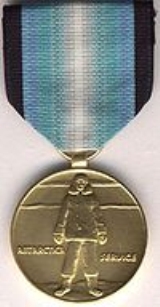
Antarctica Service Medal
Encyclopedia
The Antarctica Service Medal was established by the United States Congress
on July 7, 1960 under Public Law 600 of the 86th Congress
. The medal was intended as a military award
to replace several commemorative awards which had been issued for previous Antarctica expeditions from 1928 to 1941. The following commemorative medals were declared obsolete, following the creation of the Antarctica Service Medal.
The Antarctica Service Medal is considered an award of the United States military, issued in the name of the Department of Defense
, and is authorized for wear on active duty uniforms. The medal may also be awarded to U.S. civilians, but after the initial award, the civilian may only wear the miniature or the lapel pin depending on the occasion.
To qualify for the Antarctica Service Medal, personnel must serve between fifteen to thirty days stationed on the Antarctic continent, defined as south of 60 degrees
latitude
. Flight crews performing transport missions to Antarctica qualify for one day of service for each flight mission performed within a twenty four hour time period.
The Arctic
equivalents of the Antarctica Service Medal are the Navy Arctic Service Ribbon, the Coast Guard Arctic Service Medal
and the Air Force Overseas Short Tour Service Ribbon with Arctic "A" Device.
The Wintered Over Device is bestowed to indicate the number of winters served on the Antarctica continent. The device is worn as a disk on the award ribbon and is issued in bronze for one winter service, gold for two, and silver for three or more winters of service. On the full sized medal a clasp is worn, issued in the same degree, inscribed with the words "Wintered Over".
United States Congress
The United States Congress is the bicameral legislature of the federal government of the United States, consisting of the Senate and the House of Representatives. The Congress meets in the United States Capitol in Washington, D.C....
on July 7, 1960 under Public Law 600 of the 86th Congress
86th United States Congress
The Eighty-sixth United States Congress was a meeting of the legislative branch of the United States federal government, composed of the United States Senate and the United States House of Representatives. It met in Washington, DC from January 3, 1959 to January 3, 1961, during the last two years...
. The medal was intended as a military award
Awards and decorations of the United States military
Awards and decorations of the United States Military are military decorations which recognize service and personal accomplishments while a member of the United States armed forces...
to replace several commemorative awards which had been issued for previous Antarctica expeditions from 1928 to 1941. The following commemorative medals were declared obsolete, following the creation of the Antarctica Service Medal.
- Byrd Antarctic Expedition Medal
- Second Byrd Antarctic Expedition Medal
- United States Antarctic Expedition MedalUnited States Antarctic Expedition MedalThe United States Antarctic Expedition Medal is a combined military-civilian award that was authorized by the United States Congress on September 24, 1945 under Public Law 185 of the 79th Congress...
The Antarctica Service Medal is considered an award of the United States military, issued in the name of the Department of Defense
United States Department of Defense
The United States Department of Defense is the U.S...
, and is authorized for wear on active duty uniforms. The medal may also be awarded to U.S. civilians, but after the initial award, the civilian may only wear the miniature or the lapel pin depending on the occasion.
To qualify for the Antarctica Service Medal, personnel must serve between fifteen to thirty days stationed on the Antarctic continent, defined as south of 60 degrees
60th parallel south
The 60th parallel south is a circle of latitude that is 60 degrees south of the Earth's equatorial plane. No land lies on the parallel—it crosses nothing but ocean...
latitude
Latitude
In geography, the latitude of a location on the Earth is the angular distance of that location south or north of the Equator. The latitude is an angle, and is usually measured in degrees . The equator has a latitude of 0°, the North pole has a latitude of 90° north , and the South pole has a...
. Flight crews performing transport missions to Antarctica qualify for one day of service for each flight mission performed within a twenty four hour time period.
The Arctic
Arctic
The Arctic is a region located at the northern-most part of the Earth. The Arctic consists of the Arctic Ocean and parts of Canada, Russia, Greenland, the United States, Norway, Sweden, Finland, and Iceland. The Arctic region consists of a vast, ice-covered ocean, surrounded by treeless permafrost...
equivalents of the Antarctica Service Medal are the Navy Arctic Service Ribbon, the Coast Guard Arctic Service Medal
Coast Guard Arctic Service Medal
The Coast Guard Arctic Service Medal was established in 1976 by Admiral Owen W. Siler, USCG and is awarded to any member of the United States Coast Guard who performs twenty one days of cumulative duty afloat or ashore north of the Arctic Circle....
and the Air Force Overseas Short Tour Service Ribbon with Arctic "A" Device.
Wintered Over Device
For those personnel performing extended winter service in Antarctica, a "Wintered Over" Device is authorized. The "Wintered Over" bar is only worn on the full-size medal's suspension ribbon. The smaller "disc" device is worn on the uniform ribbon to recognize this service.The Wintered Over Device is bestowed to indicate the number of winters served on the Antarctica continent. The device is worn as a disk on the award ribbon and is issued in bronze for one winter service, gold for two, and silver for three or more winters of service. On the full sized medal a clasp is worn, issued in the same degree, inscribed with the words "Wintered Over".

